|

| |
|
THE ANTIQUES JOURNAL,
March, 1965, Pages 14 through 19 |
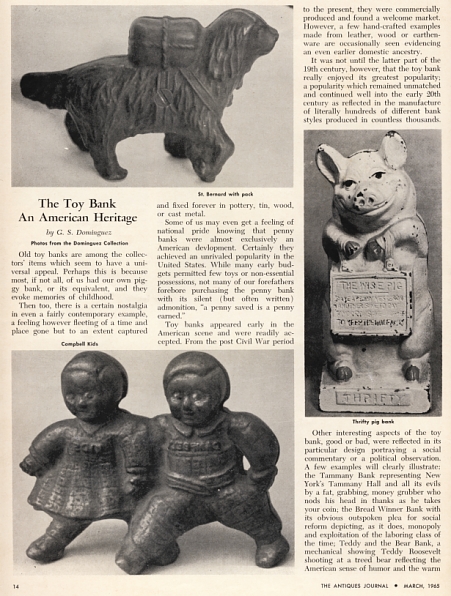 |
|
THE ANTIQUES JOURNAL,
March, 1965, Pages 14 through 19
The Toy Bank
An American Heritage
by G. S.
Dominguez
Photos from the Dominguez Collection
Old toy banks are among the collectors' items which seem to have a
universal appeal. Perhaps this is because most, if not all, of us had our
own piggy bank, or its equivalent, and they evoke memories of childhood.
Then too, there is a certain nostalgia in even a fairly contemporary
example, a feeling however fleeting of a time and place gone but to an
extent captured and fixed forever in pottery, tin, wood, or cast metal.
Some of us may even get a feeling of national pride knowing that penny
banks were almost exclusively an American development. Certainly they
achieved an unrivaled popularity in the United States. While many early
budgets permitted few toys or non-essential possessions, not many of our
forefathers forbore purchasing the penny bank with its silent (but often
written) admonition "a penny saved is a penny earned."
Toy banks appeared early in the American scene and were readily
accepted. From the post Civil War period to the present, they were
commercially produced and found a welcome market. However, a few
hand-crafted examples made from leather, wood or earthenware are
occasionally seen evidencing an even earlier ancestry.
It was not until the later part of the 19th century, however, that the
toy bank really enjoyed its greatest popularity; a popularity which remained
unmatched and continued well into the early 20th century as reflected in the
manufacture of literally hundreds of different bank styles produced in
countless thousands.
Other interesting aspects of the toy bank, good or bad, were reflected
in its particular design portraying a social commentary or political
observation. A few examples will clearly illustrate: the Tammany Bank
representing New York's Tammany Hall and its evils by a fat, grabbing, money
grubber who nods his head in thanks as he takes your coin; the Bread Winner
Bank with its obvious outspoken plea for social reform depicting, as it
does, monopoly and exploitation of the laboring class of the time; Teddy and
the Bear Bank, a mechanical showing Teddy Roosevelt shooting at a treed bear
reflecting the American sense of humor and the warm
|
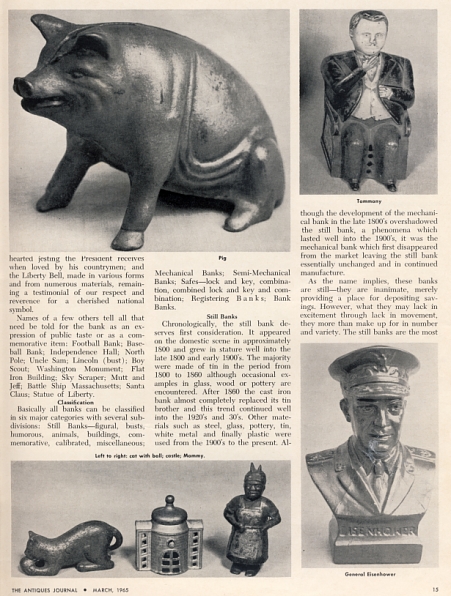 |
|
hearted jesting the President receives when loved by his countrymen; and the
Liberty Bell, made in various forms and from numerous materials, remaining a
testimonial of our respect and reverence for a cherished national symbol.
Names of a few others tell all that need be told for the bank as an
expression of public taste or as a commemorative item: Football Bank;
Baseball Bank; Independence Hall; North Pole; Uncle Sam; Lincoln (bust); Boy
Scout; Washington Monument; Flat Iron Building; Sky Scraper; Mutt and Jeff;
Battle Ship Massachusetts; Santa Claus; Statue of Liberty.
Classification
Basically all banks can be classified in six major categories with
several subdivisions: Still Banks — figural, busts, humorous, animals,
buildings, commemorative, calibrated, miscellaneous; Mechanical Banks;
Semi-Mechanical Banks; Safes — lock and key, combination, combined lock and
key and combination; Registering Banks; Bank Banks.
Still Banks
Chronologically, the still bank deserves first consideration.
It appeared on the domestic scene approximately 1800 and grew in stature
well into the 1800 and early 1900's. The majority were made of tin in the
period from 1800 to 1860 although occasionally examples in glass, wood, or
pottery are encountered. After 1860 the cast iron bank almost completely
replaced its tin brother and this trend continued well into the 1920's and
30's. Other materials such as steel, glass, pottery, tin, white metal and
finally plastic were used from the 1900's to the present. Although the
development of the mechanical bank in the late 1800's overshadowed the still
bank, a phenomena which lasted well into the 1900's, it was the mechanical
bank which first disappeared from the market leaving the still bank
essentially unchanged and in continued manufacture.
As the name implies, these banks are still — they are inanimate, merely
providing a place for depositing savings. However, what they may lack in
excitement through lack in movement, they more than make up for in number
and variety. The still banks are the most
|
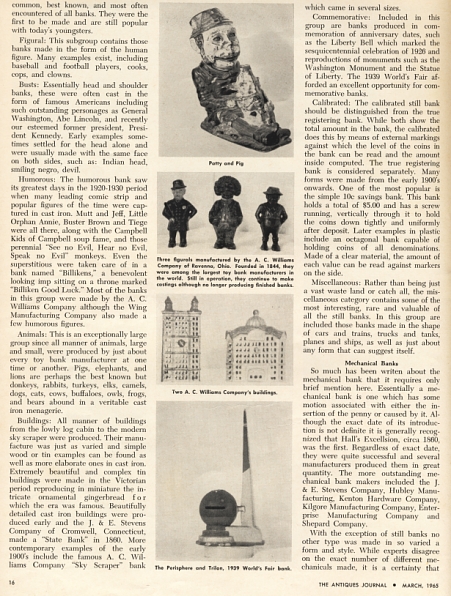 |
|
common, best known, and most often encountered of all banks. They were the
first to be made and are still popular with today's youngsters.
Figural: This subgroup contains those banks made in the form of the
human figure. Many examples exist, including baseball and football players,
cooks, cops, and clowns.
Busts: Essentially head and shoulder banks, these were often cast in
the form of famous Americans including such outstanding personages as
General Washington, Abe Lincoln, and recently our esteemed former president,
President Kennedy. Early examples sometimes settled for the head alone and
were usually made with the same face on both sides, such as: Indian head,
smiling negro, devil.
Humorous: The Humorous bank saw its greatest days in the 1920-1930
period when many leading comic strip and popular figures of the time were
captured in cast iron. Mutt and Jeff, Little Orphan Annie, Buster Brown and
Tiege were all there, along with the Campbell Kids of Campbell soup fame,
and those perennial "See no Evil, Hear no Evil, Speak no Evil" monkeys. Even
the superstitious were taken care of in a bank named "Billikens," a
benevolent looking imp sitting on a throne marked "Billiken Good Luck." Most
of the banks in this group were made by A. C. Williams Company although the
Wing Manufacturing Company also made a few humorous figures.
Animals: This is an exceptionally large group since all manner of
animals, large and small, were produced by just about every toy bank
manufacturer at one time or another. Pigs, elephants, and lions are perhaps
the best known but donkeys, rabbits, turkeys, elks, camels, dogs, cats,
cows, buffaloes, owls, frogs, and bears abound in a veritable cast iron
menagerie.
Buildings: All manner of buildings from the lowly log cabin to the
modern sky scraper were produced. Their manufacturer was just as varied and
simple wood or tin examples can be found as well as more elaborate ones in
cast iron. Extremely beautiful and complex tin buildings were made in the
Victorian period reproducing in miniature the intricate ornamental
gingerbread for which the era was famous, Beautifully detailed cast iron
buildings were produced early and the J. & E. Stevens Company of Cromwell,
Connecticut, made a "State bank" in 1860. More contemporary examples of the
early 1900's include the famous A. C. Williams include the famous A. C.
Williams Company "Sky Scraper" bank which came in several sizes.
Commemorative: Included in this group are banks produced in
commemoration of anniversary dates, such as the Liberty Bell which marked
the sesquicentennial celebration of 1926 and reproductions of monuments such
as the Washington Monument and the Statue of Liberty. The World's Fair
afforded an excellent opportunity for commemorative banks.
Calibrated: The calibrated still bank should be distinguished from the
true registering bank. While both show the total amount in the bank, the
calibrated does this by means of external markings against which the level
of coins in the bank can be read and the amount inside computed. The true
registering bank is considered separately. Many forms were made from the
early 1900's onwards. One of the most popular is the simple 10c savings
bank. This bank holds a total of $5.00 and has a screw running, vertically
through it to hold the coins down tightly and uniformly after deposit. Later
examples in plastic include an octagonal bank capable of holding coins of
all denominations. Made of a clear material, the amount of each value can be
read against markers on the side.
Miscellaneous: Rather than being just a vast waste land or catch all,
this miscellaneous category contains some of the most interesting, rare and
valuable of all the still banks. In this group are included those banks made
in the shape of cars and trains, trucks and tanks, planes and ships, as well
as just about any form that can suggest itself.
Mechanical Banks
So much has been written about the mechanical bank that it
requires only brief mention here. Essentially a mechanical bank is one which
has some motion associated with either the insertion of a penny or caused by
it. Although the exact date of its introduction is not definite it is
generally recognized that Hall's Excelsior, circa 1860, was the first.
Regardless of exact date, they were quite successful and several
manufacturers produced them in great quantity. The more outstanding
mechanical bank makers included the J. & E. Stevens Company, Hubley
Manufacturing, Kenton Hardware Company, Kilgore Manufacturing Company,
Enterprise Manufacturing Company and Shepard Company.
With the exception of still banks no other type was made in so varied a
form and style. While experts disagree on the exact number of mechanicals
made, it is a certainty that
|
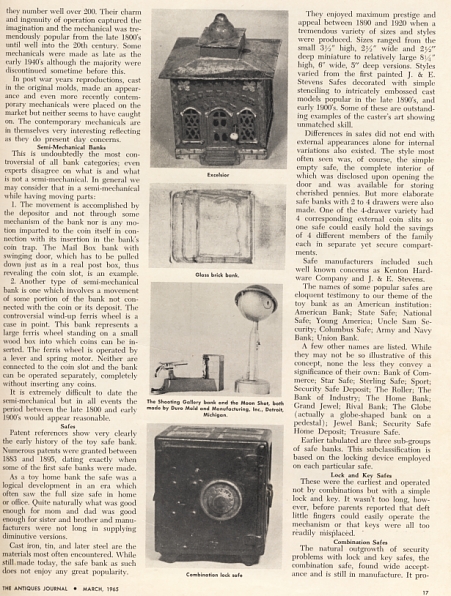 |
|
they number well over 200. Their charm and ingenuity of operation captured
the imagination and the mechanical was tremendously popular from the late
1800's until well into the 20th century. Some mechanicals were made as late
as the early 1940's although the majority were discontinued sometime before
this.
In post war years reproductions, cast in the original molds, made an
appearance and even more recently contemporary mechanicals were placed on
the market but neither seems to have caught on. The contemporary mechanicals
are in themselves very interesting reflecting as they do present day
concerns.
Semi-Mechanical Banks
This is undoubtedly the most controversial of all bank
categories; even experts disagree on what is and what is not a
semi-mechanical. In general we may consider that in a semi-mechanical while
having moving parts:
1. The movement is accomplished by the depositor and not through some
mechanism of the bank nor is any motion imparted to the coin itself in
connection with its insertion in the bank's coin trap. The Mail Box bank
with swinging door, which has to be pulled down just as in a real post box,
thus revealing the coin slot, is an example.
2. Another type of semi-mechanical bank is one which involves a
movement of some portion of the bank not connected with the coin or its
deposit. The controversial wind-up ferris wheel is a case in point. This
bank represents a large ferris wheel standing on a small wood box into which
coins can be inserted. The ferris wheel is operated by a lever and spring
motor. Neither are connected to the coin slot and the bank can be operated
separately, completely without inserting any coins.
It is extremely difficult to date the semi-mechanical but in all events
the period between the late 1800's and early 1900's would appear reasonable.
Safes
Patent references show very clearly the history of the toy safe bank.
Numerous patents were granted between 1883 and 1895, dating exactly when
some of the first safe banks were made.
As a toy home bank the safe was a logical development in an era which
often saw the full size safe in home or office. Quite naturally what was
good enough for mom and dad was good enough for sister and brother and
manufacturers were not long in supplying diminutive versions.
Cast iron, tin, and later steel are the materials most often
encountered. While still made today, the safe bank as such does not enjoy
any great popularity.
They enjoyed maximum prestige and appeal between 1890 and 1920 when a
tremendous variety of sizes and styles were produced. Sizes ranged from the
small 3-1/2" high, 2-1/2" wide and 2-1/2" deep miniature to relatively large
8-1/4" high, 6" wide, 5" deep versions. Styles varied from the first painted
J. & E. Stevens Safes decorated with simple stenciling to intricately
embossed cast models popular in the late 1890's, and early 1900's. Some of
these are outstanding examples of the caster's art showing unmatched skill.
Differences in safes did not end with external appearances alone for
internal variations also existed. The style most often seen was, of course,
the simple empty safe, the complete interior of which was disclosed upon
opening the door and was available for storing cherished pennies. But more
elaborate safe banks with 2 to 4 drawers were also made. One of the 4-drawer
variety had 4 corresponding external coin slits so one safe could easily
hold the savings of 4 different members of the family each in separate yet
secure compartments.
Safe manufacturers included such well known concerns as Kenton Hardware
Company and J. & E. Stevens Company.
The names of some popular safes are eloquent testimony to our theme of
the toy bank as an American institution: American Bank; State Safe; National
Safe; Young America; Uncle Sam Security; Columbus Safe; Army and Navy Bank;
Union Bank.
A few other names are listed. While they may not be so illustrative of
this concept, none the less they convey a significance of their own: Bank of
Commerce; Star Safe; Sterling Safe; Sport; Security Safe Deposit; The
Roller; The Bank of Industry; The Home Bank; Grand Jewel; Rival Bank; The
Globe (actually a globe-shaped bank on a pedestal); Jewel Bank; Security
Safe Home Deposit; Treasure Safe.
Earlier tabulated are three sub groups of safe banks. This
subclassification is based on the locking device employed on each particular
safe.
Lock and Key Safes
These were the earliest and operated not by combinations but with a
simple lock and key. It wasn't too long, however, before parents reported
that deft little fingers could easily operate the mechanism or that keys
were all too readily misplaced.
Combination Safes
The natural outgrowth of security problems with lock and key safes, the
combination safe, found wide acceptance and is still in manufacture. It Pro-
|
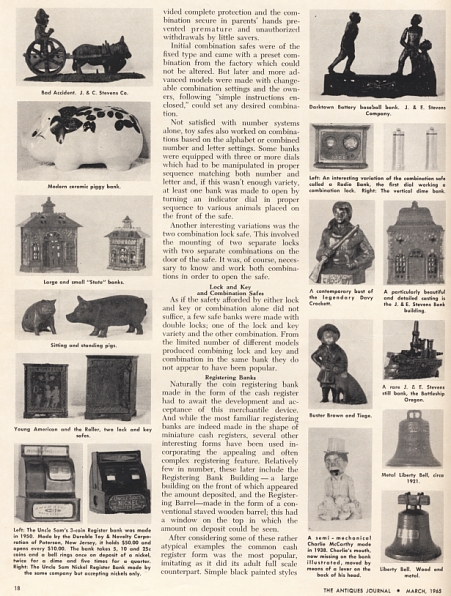 |
|
vided complete protection and the combination secure in parents' hands
prevented premature and unauthorized withdrawals by little savers.
Initial combination safes were of the fixed type and came with a preset
combination from the factory which could not be altered. But later and more
advanced models were made with changeable combination settings and the
owners, following "simple instructions enclosed," could set any desired
combination.
Not satisfied with number systems alone, toy safes also worked on
combinations based on the alphabet or combined number and letter settings.
Some banks were equipped with three or more dials which had to be
manipulated in proper sequence matching both number and letters and, if this
wasn't enough variety, at least one bank was made to open by turning an
indicator dial in proper sequence to various animals placed on the front of
the safe.
Another interesting variations was the two combination lock safe. This
involved the mounting of two separate locks with two separate combinations
on the door of the safe. It was, of course, necessary to know and work both
combinations in order to open the safe.
Lock and Key
and Combination Safes
As if the safety afforded by either lock and key or combination alone
did not suffice, , a few safe banks were made with double locks; one of the
lock and key variety and the other combination. From the limited number of
different models produced combining lock and key and combination in the same
bank they do not appear to have been popular.
Registering Banks
Naturally the coin registering bank made in the form of the cash
register had to await the development and acceptance of this merchantile
device. And while most familiar registering banks are indeed made in the
shape of miniature cash registers, several other interesting forms have been
used incorporating the appealing and often complex registering feature.
Relatively few in number, these later include the Registering Bank Building
— a large building on the front of which appeared the amount deposited, and
the Registering Barrel — made in the form of a conventional staved wooden
barrel; this had a window on the top in which the amount on deposit could be
seen.
After considering some of these rather atypical examples the common
cash register form was the most popular, imitating as it did its adult full
scale counterpart. Simple black painted styles
|
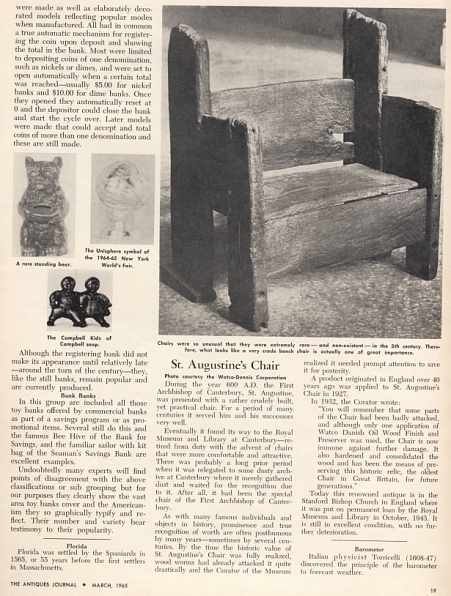 |
|
were made as well as elaborately decorated models reflecting popular modes
when manufactured. All had in common a true automatic mechanism for
registering the coin upon deposit and showing the total in the bank. Most
were limited to depositing coins in one denomination, such as nickels or
dimes, and were set to open automatically when a certain total was reached —
usually $5.00 for nickel banks and $10.00 for dime banks. Once they opened
they automatically reset at 0 and the depositor could close the bank and
start the cycle over. Later models were made that could accept and total
coins of more than one denomination and these are still made.
Although the registering bank did not make its appearance until
relatively late — around the turn of the century — they, like the still
banks, remain popular and are currently produced.
Bank Banks
In this group are included all those toy banks offered by commercial
banks as part of a savings program or as promotional items. Several still do
this and the famous Bee Hive of the Bank for Savings, and the familiar
sailor with kit bag of the Seaman's Savings Bank are excellent examples.
Undoubtedly many experts will find points of disagreement with the
above classifications or sub grouping but for our purposes they clearly show
the vast area toy banks cover and the Americanism they so graphically typify
and reflect. Their number and variety bear testimony to their popularity.
|
Penny
The word penny is believed to derive
from Penda, a ruler of the 17th century Anglian kingdom of Mercia. |
Carved Mahogany
Oldest surviving use of carved
mahogany is in the cathedral at Ciudad Trujillo built about 1514
|
Florida
Florida was settled by the Spaniards
in 1565, or 55 years before the first settlers in Massachussetts, |
Barometer
Italian physicist Torricelli
(1608-47) discovered the principle of the barometer to forecast weather. |
Rosetta Stone
The Rosetta stone, a black slab of
rock found at the mouth of the Nile River in 1799, was the key used to
decipher the early picture writing inscribed thousands of years before
Christ. It contained identical inscriptions of three different systems of
character. |
Whitney's "Gin"
Eli Whitney's cotton gin is enshrined
at savannah Ga., where it was built about 1794. The gin rests in his
original workshop, an old barn, now known as the Eli Whitney Museum.
|
|






